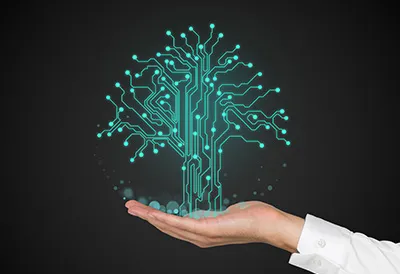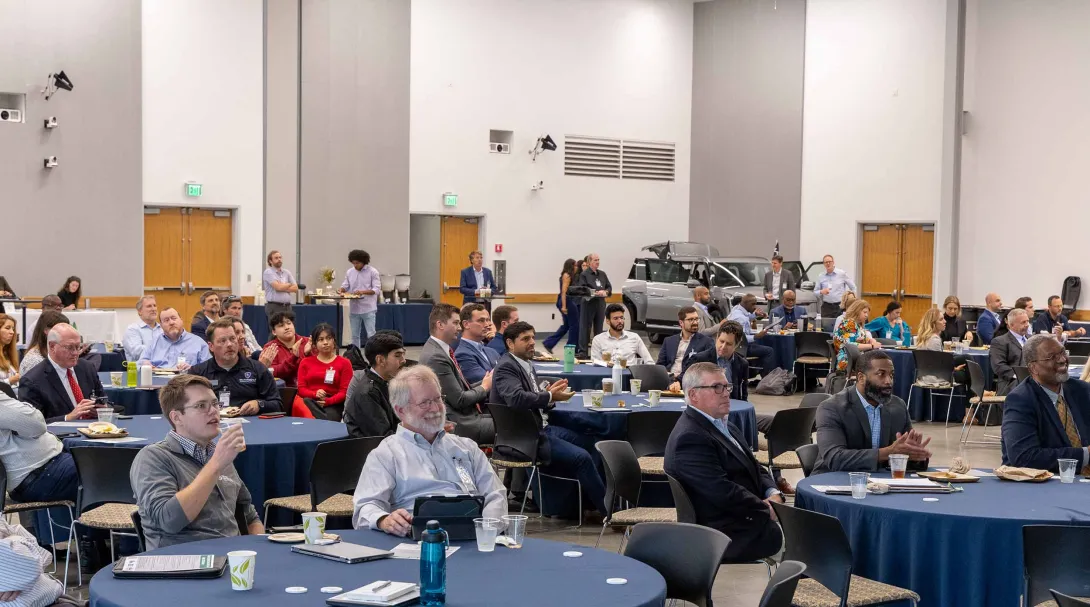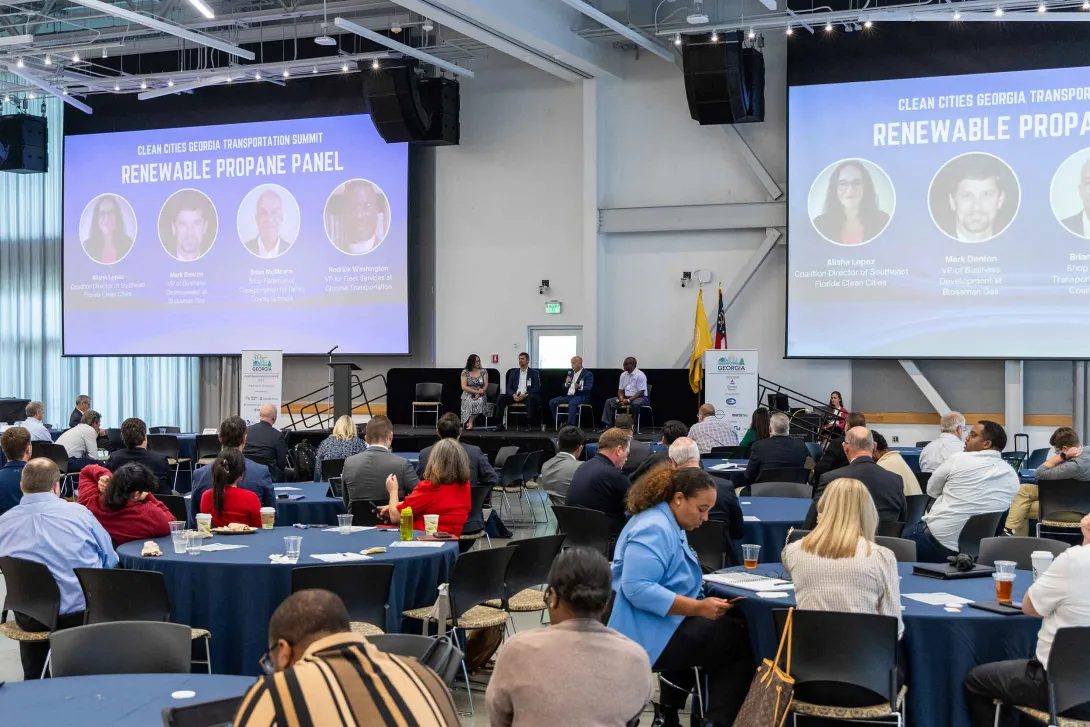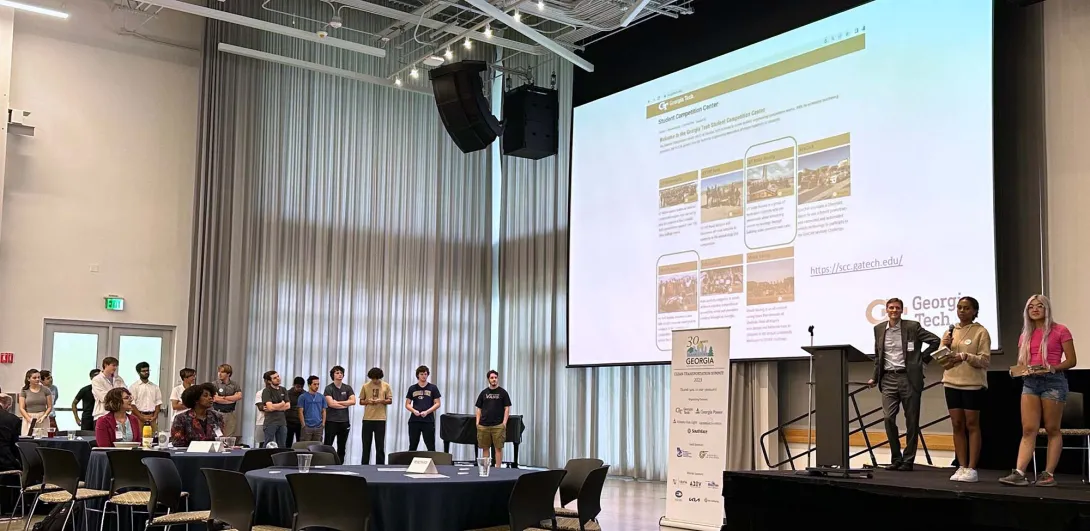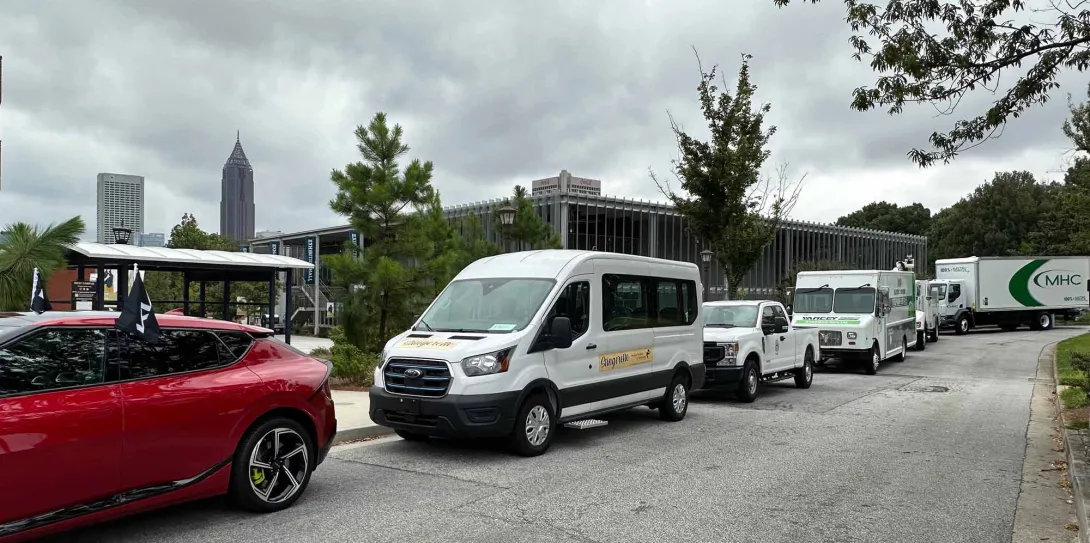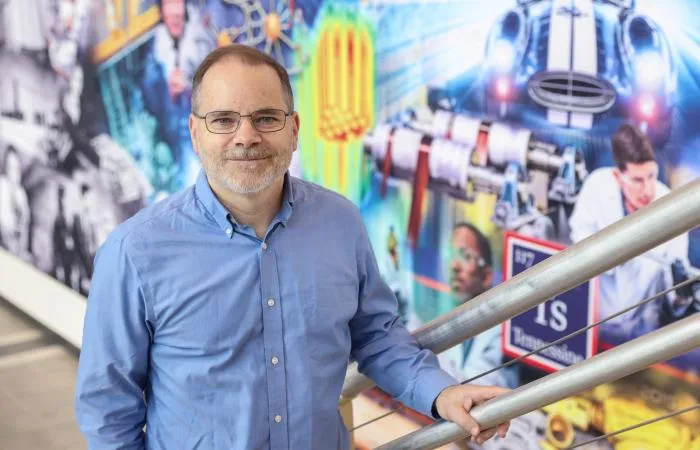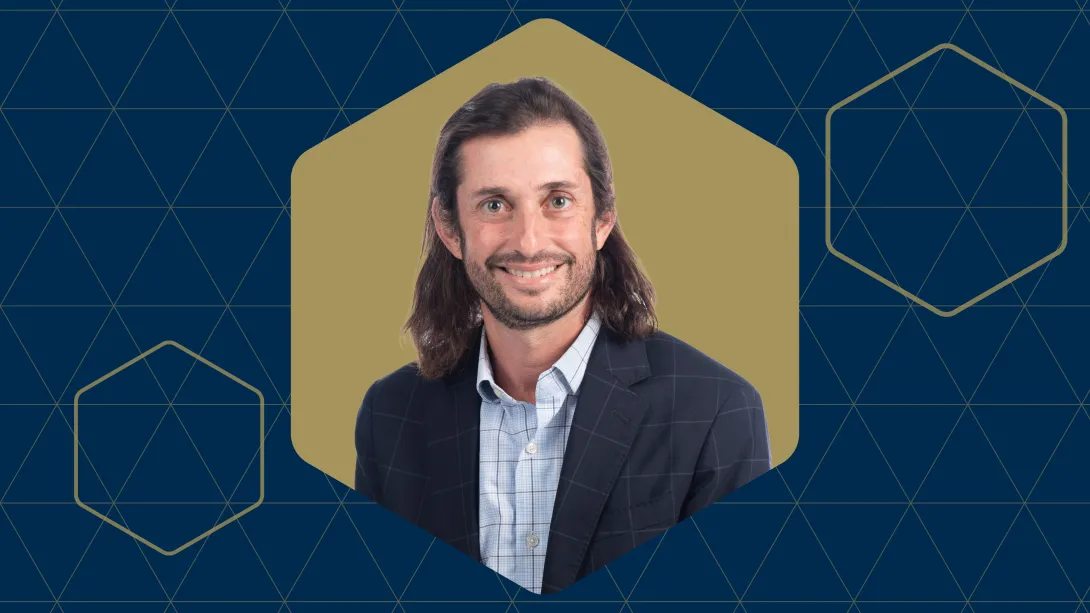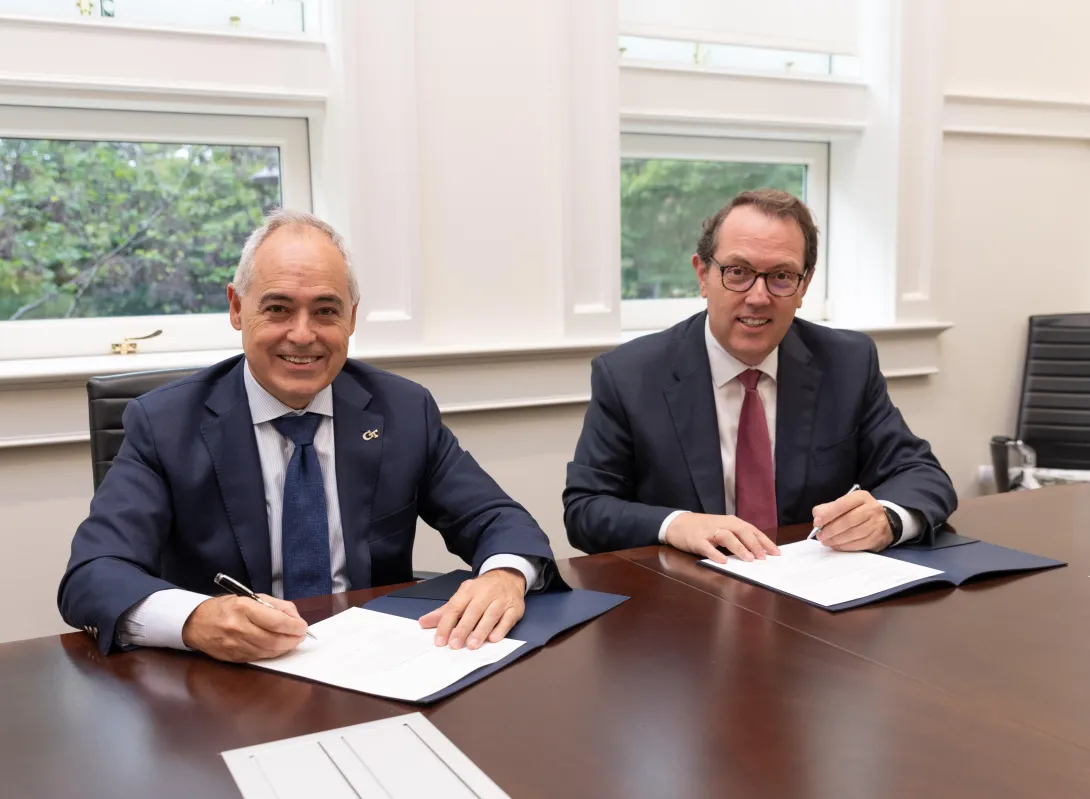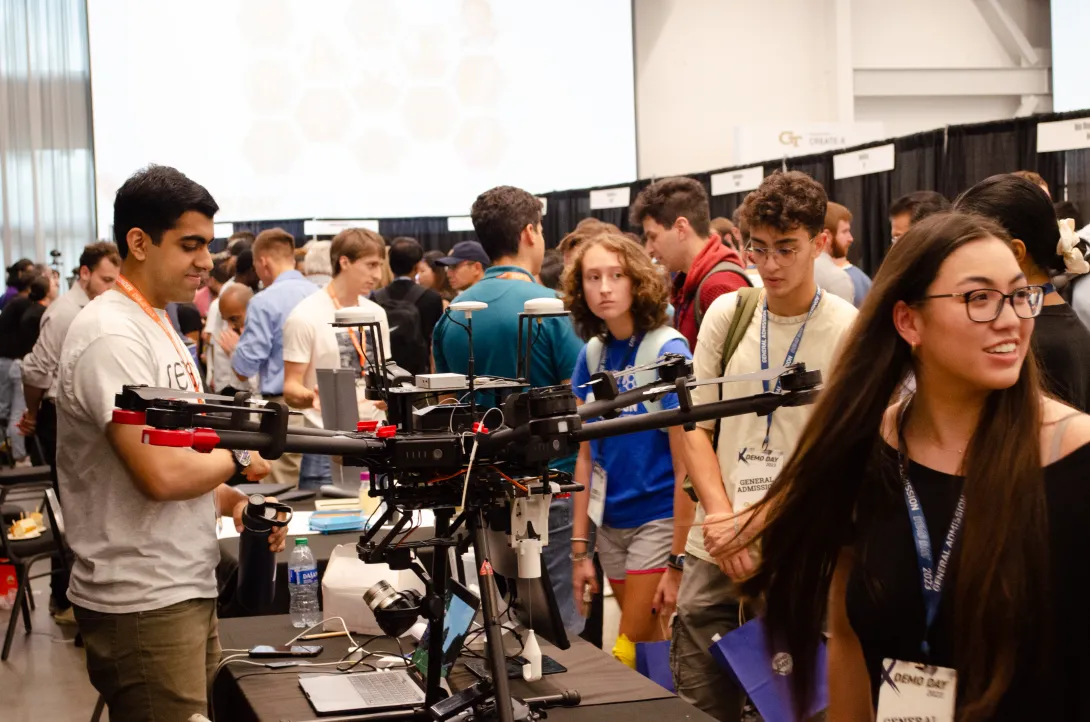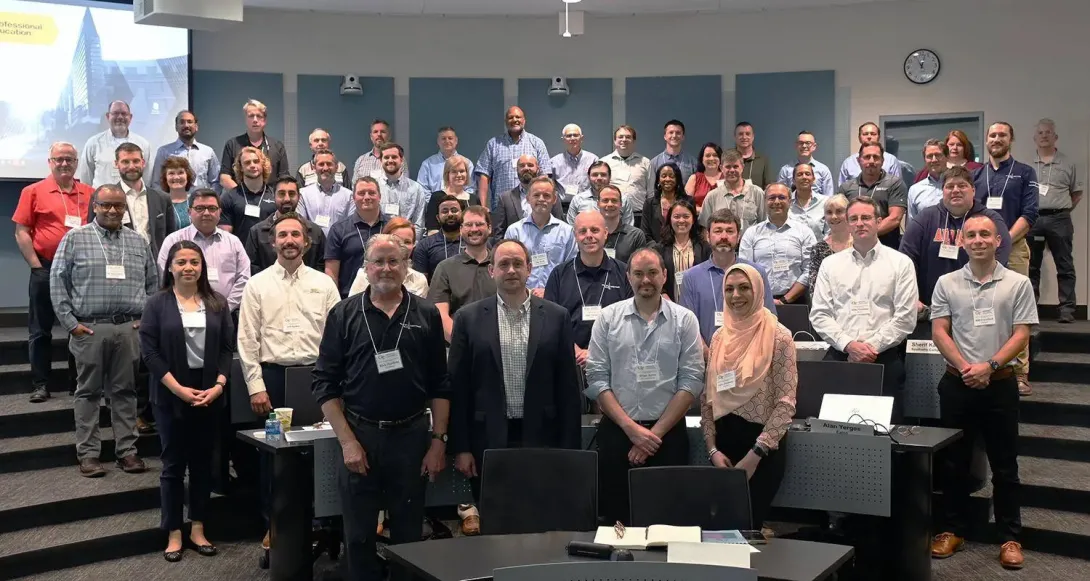Oct. 20, 2023
The Institute for Data Engineering and Science, in conjunction with several Interdisciplinary Research Institutes (IRIs) at Georgia Tech, have awarded seven teams of researchers from across the Institute a total of $105,000 in seed funding geared to better position Georgia Tech to perform world-class interdisciplinary research in data science and artificial intelligence development and deployment.
The goals of the funded proposals include identifying prominent emerging research directions on the topic of AI, shaping IDEaS future strategy in the initiative area, building an inclusive and active community of Georgia Tech researchers in the field that potentially include external collaborators, and identifying and preparing groundwork for competing in large-scale grant opportunities in AI and its use in other research fields.
Below are the 2023 recipients and the co-sponsoring IRIs:
Proposal Title: "AI for Chemical and Materials Discovery" + “AI in Microscopy Thrust”
PI: Victor Fung, CSE | Vida Jamali, ChBE| Pan Li, ECE | Amirali Aghazadeh Mohandesi, ECE
Award: $20k (co-sponsored by IMat)
Overview: The goal of this initiative is to bring together expertise in machine learning/AI, high-throughput computing, computational chemistry, and experimental materials synthesis and characterization to accelerate material discovery. Computational chemistry and materials simulations are critical for developing new materials and understanding their behavior and performance, as well as aiding in experimental synthesis and characterization. Machine learning and AI play a pivotal role in accelerating material discovery through data-driven surrogate models, as well as high-throughput and automated synthesis and characterization.
Proposal Title: " AI + Quantum Materials”
PI: Zhigang JIang, Physics | Martin Mourigal, Physics
Award: $20k (Co-Sponsored by IMat)
Overview: Zhigang Jiang is currently leading an initiative within IMAT entitled “Quantum responses of topological and magnetic matter” to nurture multi-PI projects. By crosscutting the IMAT initiative with this IDEAS call, we propose to support and feature the applications of AI on predictive and inverse problems in quantum materials. Understanding the limit and capabilities of AI methodologies is a huge barrier of entry for Physics students, because researchers in that field already need heavy training in quantum mechanics, low-temperature physics and chemical synthesis. Our most pressing need is for our AI inclined quantum materials students to find a broader community to engage with and learn. This is the primary problem we aim to solve with this initiative.
PI: Jeffrey Skolnick, Bio Sci | Chao Zhang, CSE
Proposal Title: Harnessing Large Language Models for Targeted and Effective Small Molecule 4 Library Design in Challenging Disease Treatment
Award: $15k (co-sponsored by IBB)
Overview: Our objective is to use large language models (LLMs) in conjunction with AI algorithms to identify effective driver proteins, develop screening algorithms that target appropriate binding sites while avoiding deleterious ones, and consider bioavailability and drug resistance factors. LLMs can rapidly analyze vast amounts of information from literature and bioinformatics tools, generating hypotheses and suggesting molecular modifications. By bridging multiple disciplines such as biology, chemistry, and pharmacology, LLMs can provide valuable insights from diverse sources, assisting researchers in making informed decisions. Our aim is to establish a first-in-class, LLM driven research initiative at Georgia Tech that focuses on designing highly effective small molecule libraries to treat challenging diseases. This initiative will go beyond existing AI approaches to molecule generation, which often only consider simple properties like hydrogen bonding or rely on a limited set of proteins to train the LLM and therefore lack generalizability. As a result, this initiative is expected to consistently produce safe and effective disease-specific molecules.
PI: Yiyi He, School of City & Regional Plan | Jun Rentschler, World Bank
Proposal Title: “AI for Climate Resilient Energy Systems”
Award: $15k (co-sponsored by SEI)
Overview: We are committed to building a team of interdisciplinary & transdisciplinary researchers and practitioners with a shared goal: developing a new framework which model future climatic variations and the interconnected and interdependent energy infrastructure network as complex systems. To achieve this, we will harness the power of cutting-edge climate model outputs, sourced from the Coupled Model Intercomparison Project (CMIP), and integrate approaches from Machine Learning and Deep Learning models. This strategic amalgamation of data and techniques will enable us to gain profound insights into the intricate web of future climate-change-induced extreme weather conditions and their immediate and long-term ramifications on energy infrastructure networks. The seed grant from IDEaS stands as the crucial catalyst for kick-starting this ambitious endeavor. It will empower us to form a collaborative and inclusive community of GT researchers hailing from various domains, including City and Regional Planning, Earth and Atmospheric Science, Computer Science and Electrical Engineering, Civil and Environmental Engineering etc. By drawing upon the wealth of expertise and perspectives from these diverse fields, we aim to foster an environment where innovative ideas and solutions can flourish. In addition to our internal team, we also have plans to collaborate with external partners, including the World Bank, the Stanford Doerr School of Sustainability, and the Berkeley AI Research Initiative, who share our vision of addressing the complex challenges at the intersection of climate and energy infrastructure.
PI: Jian Luo, Civil & Environmental Eng | Yi Deng, EAS
Proposal Title: “Physics-informed Deep Learning for Real-time Forecasting of Urban Flooding”
Award: $15k (co-sponsored by BBISS)
Overview: Our research team envisions a significant trend in the exploration of AI applications for urban flooding hazard forecasting. Georgia Tech possesses a wealth of interdisciplinary expertise, positioning us to make a pioneering contribution to this burgeoning field. We aim to harness the combined strengths of Georgia Tech's experts in civil and environmental engineering, atmospheric and climate science, and data science to chart new territory in this emerging trend. Furthermore, we envision the potential extension of our research efforts towards the development of a real-time hazard forecasting application. This application would incorporate adaptation and mitigation strategies in collaboration with local government agencies, emergency management departments, and researchers in computer engineering and social science studies. Such a holistic approach would address the multifaceted challenges posed by urban flooding. To the best of our knowledge, Georgia Tech currently lacks a dedicated team focused on the fusion of AI and climate/flood research, making this initiative even more pioneering and impactful.
Proposal Title: “AI for Recycling and Circular Economy”
PI: Valerie Thomas, ISyE and PubPoly | Steven Balakirsky, GTRI
Award: $15k (co-sponsored by BBISS)
Overview: Most asset management and recycling use technology that has not changed for decades. The use of bar codes and RFID has provided some benefits, such as for retail returns management. Automated sorting of recyclables using magnets, eddy currents, and laser plastics identification has improved municipal recycling. Yet the overall field has been challenged by not-quite-easy-enough identification of products in use or at end of life. AI approaches, including computer vision, data fusion, and machine learning provide the additional capability to make asset management and product recycling easy enough to be nearly autonomous. Georgia Tech is well suited to lead in the development of this application. With its strength in machine learning, robotics, sustainable business, supply chains and logistics, and technology commercialization, Georgia Tech has the multi-disciplinary capability to make this concept a reality, in research and in commercial application.
Proposal Title: “Data-Driven Platform for Transforming Subjective Assessment into Objective Processes for Artistic Human Performance and Wellness”
PI: Milka Trajkova, Research Scientist/School of Literature, Media, Communication | Brian Magerko, School of Literature, Media, Communication
Award: $15k (co-sponsored by IPaT)
Overview: Artistic human movement at large, stands at the precipice of a data-driven renaissance. By leveraging novel tools, we can usher in a transparent, data-driven, and accessible training environment. The potential ramifications extend beyond dance. As sports analytics have reshaped our understanding of athletic prowess, a similar approach to dance could redefine our comprehension of human movement, with implications spanning healthcare, construction, rehabilitation, and active aging. Georgia Tech, with its prowess in AI, HCI, and biomechanics is primed to lead this exploration. To actualize this vision, we propose the following research questions with ballet as a prime example of one of the most complex types of artistic movements: 1) What kinds of data - real-time kinematic, kinetic, biomechanical, etc. captured through accessible off-the-shelf technologies, are essential for effective AI assessment in ballet education for young adults?; 2) How can we design and develop an end-to-end ML architecture that assesses artistic and technical performance?; 3) What feedback elements (combination of timing, communication mode, feedback nature, polarity, visualization) are most effective for AI- based dance assessment?; and 4) How does AI-assisted feedback enhance physical wellness, artistic performance, and the learning process in young athletes compared to traditional methods?
- Christa M. Ernst
News Contact
Christa M. Ernst | Research Communications Program Manager
Robotics | Data Engineering | Neuroengineering
christa.ernst@research.gatech.edu
Oct. 19, 2023
Three Georgia Tech School of Earth and Atmospheric Sciences researchers — Professor and Associate Chair Annalisa Bracco, Professor Taka Ito, and Georgia Power Chair and Associate Professor Chris Reinhard — will join colleagues from Princeton, Texas A&M, and Yale University for an $8 million Department of Energy (DOE) grant that will build an “end-to-end framework” for studying the impact of carbon dioxide removal efforts for land, rivers, and seas.
The proposal is one of 29 DOE Energy Earthshot Initiatives projects recently granted funding, and among several led by and involving Georgia Tech investigators across the Sciences and Engineering.
Overall, DOE is investing $264 million to develop solutions for the scientific challenges underlying the Energy Earthshot goals. The 29 projects also include establishing 11 Energy Earthshot Research Centers led by DOE National Laboratories.
The Energy Earthshots connect the Department of Energy's basic science and energy technology offices to accelerate breakthroughs towards more abundant, affordable, and reliable clean energy solutions — seeking to revolutionize many sectors across the U.S., and relying on fundamental science and innovative technology to be successful.
Carbon Dioxide Removal
The School of Earth and Atmospheric Sciences project, “Carbon Dioxide Removal and High-Performance Computing: Planetary Boundaries of Earth Shots,” is part of the agency’s Science Foundations for the Energy Earthshots program. Its goal is to create a publicly-accessible computer modeling system that will track progress in two key carbon dioxide removal (CDR) processes: enhanced earth weathering, and global ocean alkalinization.
In enhanced earth weathering, carbon dioxide is converted into bicarbonate by spreading minerals like basalt on land, which traps rainwater containing CO2. That gets washed out by rivers into oceans, where it is trapped on the ocean floor. If used at scale, these nature-based climate solutions could remove atmospheric carbon dioxide and alleviate ocean acidification.
The research team notes that there is currently “no end-to-end framework to assess the impacts of enhanced weathering or ocean alkalinity enhancement — which are likely to be pursued at the same time.”
“The proposal is for a three-year effort, but our hope is that the foundation we lay down in that time will represent a major step forward in our ability to track carbon from land to sea,” says Reinhard, the Georgia Power Chair who is a co-investigator on the grant.
“Like many folks interested in better understanding how climate interventions might impact the Earth system across scales, we are in some ways building the plane in midair,” he adds. “We need to develop and validate the individual pieces of the system — soils, rivers, the coastal ocean — but also wire them up and prove from observations on the ground how a fully integrated model works.”
That will involve the use of several existing computer models, along with Georgia Tech’s PACE supercomputers, Professor Ito explains. “We will use these models as a tool to better understand how the added alkalinity, carbon and weathering byproducts from the soils and rivers will eventually affect the cycling of nutrients, alkalinity, carbon and associated ecological processes in the ocean,” Ito adds. “After the model passes the quality check and we have confidence in our output, we can start to ask many questions about assessment of different carbon sequestration approaches or downstream impacts on ecosystem processes.”
Professor Bracco, whose recent research has focused on rising ocean heat levels, says CDR is needed just to keep ocean systems from warming about 2 degrees centigrade (Celsius).
“Ninety percent of the excess heat caused by greenhouse gas emissions is in the oceans,” Bracco shares, “and even if we stop emitting all together tomorrow, that change we imprinted will continue to impact the climate system for many hundreds of years to come. So in terms of ocean heat, CDRs will help in not making the problem worse, but we will not see an immediate cooling effect on ocean temperatures. Stabilizing them, however, would be very important.”
Bracco and co-investigators will study the soil-river-ocean enhanced weathering pipeline “because it’s definitely cheaper and closer to scale-up.” Reverse weathering can also happen on the ocean floor, with new clays chemically formed from ocean and marine sediments, and CO2 is included in that process. “The cost, however, is higher at the moment. Anything that has to be done in the ocean requires ships and oil to begin,” she adds.
Reinhard hopes any tools developed for the DOE project would be used by farmers and other land managers to make informed decisions on how and when to manage their soil, while giving them data on the downstream impacts of those practices.
“One of our key goals will also be to combine our data from our model pipeline with historical observational data from the Mississippi watershed and the Gulf of Mexico,” Reinhard says. “This will give us some powerful new insights into the impacts large-scale agriculture in the U.S. has had over the last half-century, and will hopefully allow us to accurately predict how business-as-usual practices and modified approaches will play out across scales.”
News Contact
Writer: Renay San Miguel
Communications Officer II/Science Writer
College of Sciences
404-894-5209
Editor: Jess Hunt-Ralston
Oct. 18, 2023
The Georgia Tech Energy, Policy, and Innovation Center, in partnership with Clean Cities Georgia, Atlanta Gas Light, Georgia Chamber of Commerce, Georgia Power, and Southface Institute, hosted the 2023 Clean Cities Georgia Transportation Summit in September. The event highlighted the successes and benefits of all forms of clean transportation in Georgia and across the nation and provided an opportunity for more than 100 attendees to network and build public-private partnerships. The summit also honored the 30th anniversary of the Department of Energy’s (DOE) National Clean Cities Network, and Clean Cities Georgia, which was the first coalition founded in 1993.
Tim Lieuwen, executive director of the Georgia Tech Strategic Energy Institute, Ian Skelton, natural gas vehicles director of Atlanta Gas Light, and Frank Norris, executive director of Clean Cities Georgia, provided the welcome and opening remarks followed by a panel of executives from UPS, Chevron, and the DeKalb County Fleet Management who discussed the benefits of adopting clean fuels for businesses.
“I am excited that Georgia Tech continues to play an integral role in convening industry and community in the local region and helping to build strong relationships that will positively impact the regional and national energy landscape,” said Lieuwen, Regents’ Professor and David S. Lewis Jr. Chair in the Daniel Guggenheim School of Aerospace Engineering. “Events like this tap into the regional expertise within academia, businesses, nongovernmental organizations, and research facilities, which speaks to the vision of EPICenter.”
The daylong summit consisted of panels discussing use cases for alternate fuels available in the market: natural gas/renewable natural gas, electric vehicle (EV) applications, propane and renewable propane, biofuels and sustainable aviation fuels, and current and future hydrogen applications. Panelists shared processes and considerations that led to the successful implementation of alternate fuels within their organization, including choosing locations, procurement, state and regional policies, incentives, effects on the community, improvements in current processes, reduced carbon footprint, and scalability while shifting from fossil to alternate fuels.
Panelists from Cobb, DeKalb, and Henry counties shared successful implementations of alternate fuel vehicles in their respective localities that included propane, renewable natural gas and EVs and showcased some of their alternate fuel vehicles during the summit. Workforce development and infrastructure concerns included training new electricians, aging line men in the region, and future proofing charging stations. Transformer supply chain issues were also brought to the forefront during discussions throughout the day.
Representatives from the Office of Energy Efficiency and Renewable Energy and the U.S. Environmental Protection Agency spoke to the audience on how to work with their respective agencies to get federal funding in this area. The event ended with a 30-year review of Clean Cities Georgia, a nonprofit that started as the first initiative of the DOE to focus on strategies to reduce petroleum consumption in transportation. There are now nearly 100 coalitions across the country.
The event was part of National Drive Electric Week, which took place during the last week of September. Presentations and other details from the summit can be accessed through the 2023 Clean Cities Georgia summit webpage.
News Contact
Priya Devarajan || Research Communications Program Manager
Oct. 18, 2023
David Sholl, a professor in Georgia Tech’s School of Chemical and Biomolecular Engineering (ChBE), is leading a new Energy Earthshot Research Center (EERC) at the Department of Energy's Oak Ridge National Laboratory (ORNL) that is focused on developing chemical processes that use sustainable methods instead of burning fossil fuels to radically reduce industrial greenhouse gas emissions to stem climate change and limit the crisis of a rapidly warming planet.
Sholl, who is director of ORNL’s Transformational Decarbonization Initiative, is director of the ORNL-led Non-Equilibrium Energy Transfer for Efficient Reactions (NEETER), which also involves ChBE faculty members Fani Boukouvala and Carsten Sievers as key members.
NEETER is one of two new DoE EERCs involving ChBE faculty; the other (co-led by Professor David Flaherty) is Harnessing Electrostatics for the Conversion of Organics, Water and Air: Driving Redox on Particulate Liquids Earthshot (DROPLETS).
Debaronizing Large-scale Processes
NEETER will coordinate a research team from across the nation focused on replacing bulk heating for chemical processes with electrified means, providing a new way to do chemistry, and decarbonizing large-scale processes in the chemical industry. The Department of Energy has committed $19 million over four years for the center.
“This center is an exciting opportunity to advance innovative methods for performing important chemical reactions with heat derived from electricity instead of burning fossil fuels,” Sholl said. “Our world-class team will combine powerful fundamental insights with leadership-class computing to push forward use of mechanochemistry and resistive heating to achieve chemical outcomes that are simply not possible with traditional heating methods.”
Sholl, who also serves as interim executive director of the University of Tennessee Oak Ridge Innovation Institute, will lead the NEETER effort to harness the expertise of more than 20 co-principal investigators from two other national laboratories and several universities.
In addition to ORNL, other center investigators come from DOE’s SLAC National Accelerator Laboratory at Stanford University and the Princeton Plasma Physics Laboratory, Delaware State University, the Georgia Institute of Technology, Princeton University, the University of Houston, and the University of Maryland.
The scientists, in addition to using their own laboratories, will use DOE Office of Science user facilities, including ORNL’s Oak Ridge Leadership Computing Facility, Spallation Neutron Source, High Flux Isotope Reactor, and Center for Nanophase Materials Sciences. They will also include the beam line at SLAC.
Energy Earthshot Goals
“Our Energy Earthshots are game-changing endeavors to unleash the technologies of the clean energy transition and make them accessible, affordable, and abundant,” said U.S. Secretary of Energy Jennifer M. Granholm. “The Energy Earthshot Research Centers and the related work happening on college campuses around the country will be instrumental in developing the clean energy and decarbonization solutions we need to establish a 100% clean grid and beat climate change.”
NEETER’s proposed research is a radical departure from traditional chemistry and holds promise for transformational breakthroughs in energy-related chemical reactions. The NEETER EERC addresses the DOE’s Industrial Heat Shot announced in 2022, which aims to develop cost-competitive industrial heat decarbonization technologies with at least 85% lower greenhouse gas emissions by 2035. This EERC will employ new kinds of chemical catalysis as one pathway toward electrifying the delivery of process heat.
Industrial heat involves the burning of fossil fuels, which contributes massive amounts of carbon dioxide to the atmosphere. About 40% of those emissions come from chemicals and refining procedures. Because many industrial processes require extremely high energy, decarbonizing these chemical processes via electrification would radically alter the industrial chemical landscape.
Researchers propose two main ways of electrification, Sholl explained. One is through a process called mechanocatalysis, which creates mechanically initiated reactions. Another is Joule heating — using electricity to achieve very rapid temperature increases. The aim is to control chemical reactivity through temperature and pressure, by rapid heating in the Joule heating case, or by mechanical collisions in the case of mechanocatalysis.
NEETER’s mission is “To understand and control spatial and temporal non-equilibrium heat transfer to enable transformational breakthroughs in energy- and atom-efficient endothermic catalytic reactions beyond limitations of thermodynamic and kinetic equilibrium to decarbonize the US chemical industry.”
Said Sholl, “We envision a future where we use renewable electricity to provide heat and produce chemicals without greenhouse gas emissions.”
DROPLETS Earthshot
David Flaherty, a professor in Georgia Tech’s School of Chemical and Biomolecular Engineering, is co-principal investigator of another Energy Earthshot Energy Research Center called Harnessing Electrostatics for the Conversion of Organics, Water and Air: Driving Redox on Particulate Liquids Earthshot (DROPLETS).
The overall objective of DROPLETS is to explore an unconventional, straightforward, and underutilized approach based on microdroplet-enabled redox reactions (which involve the transfer of electrons between substances) towards H2 production (a clean and renewable energy source), CO2 activation (which can help mitigate greenhouse gas emissions), and the synthesis of redox species for long-duration energy storage (LDES).
DROPLETS strives to achieve simplicity and lower the energy input and reactor cost for complex chemical reactions, a key advantage to simultaneously achieve multiple Energy Earthshots, including the Hydrogen Shot, the Long Duration Storage Shot, and the Carbon Negative Shot.
DROPLETS is led by Professor Joaquin Rodriguez Lopez of the University of Illinois, Urbana-Champaign.
News Contact
Brad Dixon, braddixon@gatech.edu
Sep. 28, 2023
For the second time in three years, a Georgia Tech School of Public Policy faculty member has won the prestigious World Citizen Prize in Environmental Performance.
The Association for Public Policy Analysis & Management (APPAM) recently revealed Professor Daniel Matisoff as one of its 2023 honorees, along with his collaborator Douglas Noonan, formerly a professor in the School and now at Indiana University — Purdue University Indianapolis. APPAM also honored Lucy Qiu of the University of Maryland.
The Association for Public Policy Analysis & Management (APPAM) gives the annual award in recognition of research that “assesses pathways to achieve measurable but as-yet-unrealized gains in overall environmental performance.”
“It’s quite an honor to receive this award with Doug for the work that we’ve done to understand what we call the ‘green market transformation,’” Matisoff said. “It’s also gratifying to see continued recognition of the excellent work being done across the School.”
Matisoff and Noonan won for their book Ecolabels, Innovation, and Green Market Transformation.
In announcing the win, APPAM said Ecolabels “provides a new perspective on leveraging markets to transform industry” through its analysis of eco-labeling — the voluntary practice among some companies of acquiring independent certification that their goods or services are more environmentally friendly.
The book focuses on the building industry and certifications such as the Leadership in Energy & Environmental Design, or LEED, program. In the volume, Matisoff and Noonan show that early adopters of such programs help spur adoption across the industry.
“The theory for the work was inspired by the mission of the Kendeda Building at Georgia Tech, which was designed to transform how building and construction are done in the Southeast,” Matisoff said. “We showed that tools that leverage interactions between the public and private sector, such as eco-labeling and pilot and demonstration projects, can help build supply chains, reduce costs, demonstrate the performance of risky technologies, and accelerate uptake of innovative energy and environmental technologies.”
Matisoff will accept the award at the APPAM meeting scheduled to be in Atlanta this November.
Marilyn A. Brown, Regents’ Professor and Brook Byers Professor of Sustainable Systems in the School of Public Policy, received the award in 2021 for her work leading the research team behind the Drawdown Georgia climate initiative. Matisoff is also a member of that team.
In all, three of the seven recipients of the award since its inception in 2019 have been current or former faculty members of Georgia Tech’s School of Public Policy. That track record demonstrates the School’s tradition of leadership and creativity in the energy and environmental policy space, Matisoff said.
“It speaks to the caliber of our faculty and our energy and environmental policy program here at the Georgia Tech School of Public Policy,” said Matisoff, who is also the director of the innovative Master of Sustainable Energy and Environmental Management program.
The School of Public Policy is a unit of the Ivan Allen College of Liberal Arts.
News Contact
Michael Pearson
Ivan Allen College of Liberal Arts
Sep. 26, 2023
Ferrovial, a global infrastructure operator, and the Georgia Institute of Technology today announced a long-term partnership focused on advancing innovation in transport infrastructure. The partnership will allow for joint research activities, providing new educational and development opportunities for students and enabling Ferrovial to create a more sustainable future for mobility. The agreement was formally signed at the university’s campus in Atlanta.
"Georgia Tech is globally recognized for its expertise in infrastructure and mobility, research, and development,” said Andres Sacristan, CEO of Cintra Global. “Ferrovial understands our industry must remain agile as transportation continues to evolve. By partnering with universities like Georgia Tech, we can continue to improve the traveler experience and better serve our clients by providing new mobility solutions."
Ferrovial has collaborated with Georgia Tech in research, leveraging its talent for several years. In addition to its expertise in traffic engineering, the Institute has extensive research capabilities in construction, airports, and energy, allowing for a comprehensive and diversified partnership as Ferrovial operates in all these areas.
“Ferrovial is reimagining transportation, and this collaboration will enable Georgia Tech researchers and students to gain a firsthand understanding of the needs of our nation’s infrastructure,” said Ángel Cabrera, president of Georgia Tech. “We are proud to partner with Ferrovial to drive the future of transportation and mobility, which will bring valuable technological innovation and knowledge transfer to our state.”
Ferrovial, through its highways business Cintra, operates five major managed lane projects across the U.S., providing traffic congestion relief to some of the nation’s fastest growing regions. Ferrovial's construction division currently manages several large highway construction projects, including the Transform 285/400 highway improvement project in Atlanta. Subsidiaries Ferrovial Construction and Webber have carried out infrastructure improvements in the state of Georgia that amount to nearly $800 million. Ferrovial Airports is a leading airport investor and operator with key investments in the U.S. Through its vertiports business, the company aims to design, build, and operate the infrastructure required by eVTOL (electric Vertical Take-Off and Landing) aircraft.
“Aligning with Georgia Tech reinforces Ferrovial’s commitment to sustainably advancing mobility, enhancing safety, and connecting communities in the United States and beyond,” said Sacristan.
News Contact
Blair Meeks | blair.meeks@gatech.edu
Sep. 21, 2023
For the 10th Demo Day, the Tech community came out in droves to support 75 Georgia Tech startups created by students, alumni, and faculty. In booths spread out in Exhibition Hall, they displayed their products, which ranged from AI and robotic training gear to fungi fashion, and more. Over four hours, more than 1,500 people filed in and out of the hall. Founders pitched their innovations to business and community leaders, as well as students and the public, eager to witness groundbreaking innovations across various industries.
Kiandra Peart, co-founder of Reinvend, said the amount of people surprised her.
“After the first VIP session was over, hundreds of people were just flooding through the door at all times,” she said. “We had to give the pitch a million times to explain it to a lot of different people, but they seemed really, really engaged, and we were also able to get a few interactions.”
Reinvend is working through a potential deal with Tech Dining on using their vending machines, which would expand food options for students after dining halls close.
Demo Day is the culmination of the 12-week summer accelerator, Startup Launch, where founders learn about entrepreneurship and build out their businesses with the support of mentors. Along with guidance from experts in business, teams receive $5,000 in optional funding and $30,000 of in-kind services. This year, the program had over 100 startups and 250 founders, continuing the growth trend for CREATE-X. The program aims to eventually support the launch of 300 startups per year.
Peart said the experience taught the team how to better pitch to potential clients and formulate a call to action after a successful interaction.
Since its inception in 2014, CREATE-X has had more than 5,000 participate in their programming, which is segmented in three areas: Learn, Make, and Launch. Besides providing resources, the program also helps founders through its rich entrepreneurial ecosystem.
“We want to increase access to entrepreneurship. That’s the heart of the program, and it’s the goal to have everyone in the Tech community to have entrepreneurial confidence. The energy and passion of our founders to solve real-world problems — it’s palpable at Demo Day. I’d say it’s the best place to see what we’re about and understand what this program offers,” said Rahul Saxena, director of CREATE-X, who also reminded founders that the connections they make here would last for years.
At its core, CREATE-X is a community geared toward innovation. Participants were at the forefront of integrating OpenAI's GPT-3 when it was not yet widely adopted. They share their insights with each other, and the program has mentors coming back from even the very first cohort. Starting with eight teams, CREATE-X has now launched more than 400 startup teams, with founders representing 38 academic majors. Its total startup portfolio valuation is above $1.9 billion.
Peart compared CREATE-X to an energy drink.
“After going through the program, I was really able to refine my ideas, talk with other people, and now that the program is over, I feel energized,” she said. “I think that having an accelerator right at home allows students who may have never considered starting a company, or didn't have access to an accelerator, to actually utilize their resources from their school and their own community to get their companies started.”
Although Demo Day just ended, CREATE-X is already gearing up for the next cohort. Applications for Startup Launch opened Aug. 31, the same day as Demo Day.
“Consider interning for yourself next summer,” said Saxena. “We know you have ideas about solutions to address global challenges. You’re at Tech; you have the talent. Let us help you with the resources and support system.”
Georgia Tech students, alumni, and faculty can apply to GT Startup Launch now. The priority deadline is Nov. 6. To learn more about CREATE-X, find CREATE-X events to build a startup team, or learn more about entrepreneurship, visit th CREATE-X website
News Contact
Breanna Durham
Marketing Strategist
Sep. 12, 2023
A new $20.5 million Department of Energy project will establish a direct air capture hub in northern Mobile County, Alabama.
Carbon dioxide (CO2), the primary pollutant from emissions past and present, stays in the atmosphere for hundreds of years, leading to climate change and its many consequences. Cleaning up these legacy emissions is an essential step in the creation of a sustainable, low-carbon economy. Direct Air Capture (DAC) is an innovative solution that captures CO2 directly from the air and reduces its levels in the atmosphere. The CO2 is then stored safely and securely or utilized to make value-added products.
The Georgia Institute of Technology collaborated with the Southern States Energy Board and its partners in the deployment of a direct air capture hub in Mobile County, Alabama. Known as the Southeast DAC (SEDAC) Hub, the project is funded by the U.S. Department of Energy’s Office of Fossil Energy and Carbon Management and will deploy cutting-edge DAC technologies to capture CO2 from the air. Steered by Joe Hagerman, director of NEETRAC, and Matthew Realff, professor in the School of Chemical and Biomolecular Engineering, David Wang Sr. Fellow, and initiative lead for circular carbon economy at the Strategic Energy Institute (SEI), the team will serve the educational, workforce, and community development functions in the project that is led by the Southern States Energy Board. Other partners include 8 Rivers, Aircapture, Crescent Resource Innovation, ENTECH Strategies, Mitternight, RTI International, the University of Alabama, and the University of South Alabama. Stakeholders include Southern Company and its Alabama Power Company subsidiary, Tenaska Sequestration Solutions, and the Mobile Chamber of Commerce, among many others.
“We are thrilled to partner with the U.S. Department of Energy and the Southern States Energy Board in the SEDAC Hub project,” said Tim Lieuwen, SEI executive director, Regents’ Professor, and David S. Lewis Jr. Chair. “The project is important to the decarbonization efforts in the Southeast and will further amplify the Southeast’s leadership in the clean tech economy.”
Georgia Tech’s role will be supported by the Direct Air Capture Center (DirACC), which is the culmination of more than a decade of research at Georgia Tech to develop and evaluate materials, contactors, and processes that extract carbon dioxide directly from the atmosphere. DirACC creates a forum for collaborative research on negative emission technologies and DAC, bringing together researchers from across the Institute working in energy, sustainability, policy, and related fields. DirACC is jointly led by Christopher Jones, professor and John F. Brock III School Chair in the School of Chemical and Biomolecular Engineering, and Realff.
Mobile County is an ideal location to support the initial phases of a DAC hub. It is home to industrial facilities, large tracts of available land, and appropriate subsurface geology to support the creation of a sustainable, CO2-based economy. In addition, numerous opportunities exist to employ the region’s skilled workforce in pursuit of a variety of jobs beyond permanent storage in subsurface reservoirs (e.g., CO2 to fuels). The SEDAC Hub will not only help reduce local emissions, but also help create a carbon reduction ecosystem in the area — and the Gulf South more broadly.
The project team has established robust community outreach and a two-way engagement program that includes a community advisory board composed of diverse local stakeholders; industry partners interested in decarbonization; and local community colleges, universities, and trade schools. The board will provide input to achieve community-supported DAC growth and guide the development of SEDAC’s community benefits plan.
Visit the Project Page to learn more about the project and the team members.
Energy Research at Georgia Tech
The Georgia Institute of Technology is one of the top public research universities in the U.S., developing leaders who advance technology and improve the human condition. Georgia Tech has researchers working across the energy value chain and leads in scientific leadership in basic and applied science in carbon capture, industrial decarbonization, and related social sciences. Georgia Tech is consistently rated among the top universities in the nation for graduation of underrepresented minorities in engineering, physical sciences, and energy-related fields. Serving as a regional resource to help communities understand how they can transition to a clean energy economy, Georgia Tech is the southeastern leader in achieving regional impact through education and contributions to the community.
News Contact
Priya Devarajan | SEI Communications Program Manager
Sep. 11, 2023
The water coming out of your faucet is safe to drink, but that doesn’t mean it’s completely clean. Chlorine has long been the standard for water treatment, but it often contains trace levels of disinfection byproducts and unknown contaminants. Georgia Institute of Technology researchers developed the minus approach to handle these harmful byproducts.
Instead of relying on traditional chemical addition (known as the plus approach), the minus approach avoids disinfectants, chemical coagulants, and advanced oxidation processes typical to water treatment processes. It uses a unique mix of filtration methods to remove byproducts and pathogens, enabling water treatment centers to use ultraviolet light and much smaller doses of chemical disinfectants to minimize future bacterial growth down the distribution system.
“The minus approach is a groundbreaking philosophical concept in water treatment,” said Yongsheng Chen, the Bonnie W. and Charles W. Moorman IV Professor in the School of Civil and Environmental Engineering. “Its primary objective is to achieve these outcomes while minimizing the reliance on chemical treatments, which can give rise to various issues in the main water treatment stream.”
Chen and his student Elliot Reid, the primary author, presented the minus approach in the paper, “The Minus Approach Can Redefine the Standard of Practice of Drinking Water Treatment,” in The American Chemical Society.
The minus approach physically separates emerging contaminants and disinfection byproducts from the main water treatment process using these already proven processes:
- Bank filtration withdraws water from naturally occurring or constructed banks like rivers or lakes. As the water travels through the layers of soil and gravel, it naturally filters out impurities, suspended particles, and certain microorganisms.
- Biofiltration uses biological processes to treat water by passing it through filter beds made of sand, gravel, or activated carbon that can support the growth of beneficial microorganisms, which in turn can remove contaminants.
- Adsorption occurs when an adsorbent material like activated carbon is used to trap contaminants.
- Membrane filtration uses a semi-permeable membrane to separate particles and impurities from the main treatment process.
The minus approach is intended to engage the water community in designing safer, more sustainable, and more intelligent systems. Because its technologies are already available and proven, the minus approach can be implemented immediately.
It can also integrate with artificial intelligence (AI) to improve filtration’s effectiveness. AI can aid process optimization, predictive maintenance, faulty detection and diagnosis, energy optimization, and decision-support systems. AI models have also been able to reliably predict the origin of different types of pollution in source water, and models have also successfully detected pipeline damage and microbial contamination, allowing for quick and efficient maintenance.
“This innovative philosophy seeks to revolutionize traditional water treatment practices by providing a more sustainable and environmentally friendly solution,” Chen said. “By reducing the reliance on chemical treatments, the minus approach mitigates the potential risks associated with the use of such chemicals, promoting a safer water supply for both human consumption and environmental protection.”
CITATION: Elliot Reid, Thomas Igou, Yangying Zhao, John Crittenden, Ching-Hua Huang, Paul Westerhoff, Bruce Rittmann, Jörg E. Drewes, and Yongsheng Chen
Environmental Science & Technology 2023 57 (18), 7150-7161
DOI: 10.1021/acs.est.2c09389
News Contact
Tess Malone, Senior Research Writer/Editor
tess.malone@gatech.edu
Sep. 06, 2023
As the nation's power grid undergoes a transformative shift with historic investment in clean energy, Joe Hagerman understands the importance of this moment for the National Electric Energy Testing, Research and Applications Center (NEETRAC). It presents the center with a distinct opportunity to showcase expertise, drive progress, and actively shape the future of the grid.
NEETRAC, a leading research and testing resource for the electric energy industry, housed under the Georgia Tech School of Electrical and Computer Engineering (ECE), has announced the appointment of Hagerman as its director, starting June 1.
“Under the leadership of former Director Rick Hartlein, NEETRAC has established itself as a trusted authority in testing and research for the electric power industry,” said Hagerman. “Thanks to this reputation, we are now poised to take a leading role in the country's de-carbonization and re-electrification priorities. The potential for strengthening our ties with the Institute, the state of Georgia, and federal entities is a once in a lifetime opportunity.”
Hagerman joins NEETRAC after directing the Energy, Policy, and Innovation Center (EPICenter), a division of the Strategic Energy Institute.
Prior to Georgia Tech, Hagerman served as a section head at the U.S. Department of Energy’s Oak Ridge National Laboratory. He also has served as the deputy chief scientist of the ;National Rural Electric Cooperative Association and as a senior policy advisory at the U.S. Office of Energy’s Energy Efficiency and Renewable Energy.
“As NEETRAC prepares for the next phase of its journey, Joe's passion, visionary approach, and bridge-building abilities will be indispensable for success,” said Arijit Raychowdhury, professor and Steve W. Chaddick School Chair in ECE. “His policy work and technical expertise in grid systems speak for themselves, especially regarding emerging areas like renewables, connected equipment, and cybersecurity. I’m thrilled to have Joe leading the way.”
The Right Time for Growth
The domestic demand for electricity continues to steadily rise because of the government's ambitious renewable and carbon-free energy objectives, the increased electrification of transportation and heating, and the growing demand for digitally connected devices.
Add this to an aging power grid, and incentives and investments for making the grid stronger and more resilient are at an all-time high for the electric power industry.
Hagerman looks to leverage his governmental research reputation and knowledge of the Georgia Tech landscape to enhance NEETRAC's existing strengths and explore new opportunities. He seeks to establish new connections — both inside and outside of the Institute — for the center, enabling it to effectively drive innovation and address the evolving needs of the industry.
“The power grid stands as a remarkable feat of human engineering, and its sheer physical scale is incredible,” said Hagerman. “Incorporating changes is not as simple as flipping a switch. It requires extensive knowledge and countless hours of rigorous testing. Thankfully, NEETRAC and Georgia Tech possess an abundance of expertise — and a world class staff — that can be harnessed to navigate these challenges successfully.”
An Invaluable Industry Resource
For more than 25 years, NEETRAC — located just south of the Atlanta campus, near the Hartsfield-Jackson Atlanta International Airport — has played a vital role in facilitating collaboration between the electric energy industry and academia.
Everything connected to the power grid — even power poles to bucket trucks — can be tested and researched at the center. NEETRAC’s experienced engineers and technicians seek to deliver innovative, effective solutions to all problems related to the transmission and distribution of electric energy.
As a membership-supported center, NEETRAC's member companies comprise utilities that represent around 65% of U.S. electric customers, along with manufacturers who contribute significantly to the products and services offered in the electric utility industry.
“NEETRAC is much more than a testing laboratory to us,” said Sherif Kamel, vice president of New Product Development at Southwire, a NEETRAC member organization. “The deep knowledge and expertise that NEETRAC uses to support our industry’s needs is unparalleled.”
This diverse membership base promotes collaboration and knowledge exchange, keeping NEETRAC at the forefront of industry challenges, advancements, and opportunities.
Sherif, NEETRAC's advisory board chair and a member of the search committee that recommended Hagerman, stated that NEETRAC's staff and facilities aid Southwire in developing, improving, and supporting customers. Additionally, the center enhances the credibility and proficiency of the company's test results. Southwire was founded in 1937 by Roy Richards, a graduate of Georgia Tech, and is a NEETRAC founding member.
Future Potential
Hagerman stressed that with so much uncertainty regarding the future of the domestic power grid, one thing is clear: To evolve NEETRAC will need to enhance its relationship with the industry and scale to help its current and future members throughout North America.
“There’s excitement in not knowing how everything will unfold,” he said. “It’s important for us to be nimble and ready to adapt, but to also use our position to anticipate the needs of our members and provide value and insights to our partners.”
According to Hagerman, the future services of NEETRAC could be driven by several important factors, namely the integration of renewable energy sources, ensuring the security of the grid both in physical and cyber aspects, and harnessing the power of big data.
Investing and expanding in the expertise of NEETRAC's skilled scientists and engineers, its technical staff, and its administrative staff is arguably the most crucial approach to meeting the uncertain demands of the future.
“By nurturing the talents and skills of the team and by incorporating an inclusive approach, we all work toward the shared future of NEETRAC and the Institute. We are all one Georgia Tech,” said Hagerman. “NEETRAC’s role in that future is defined by its cutting-edge evaluations, its world class research, and its continued support of innovation for a resilient and secure domestic power grid for all.”
News Contact
Dan Watson
Pagination
- Previous page
- 15 Page 15
- Next page
